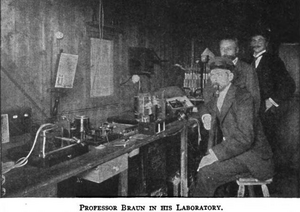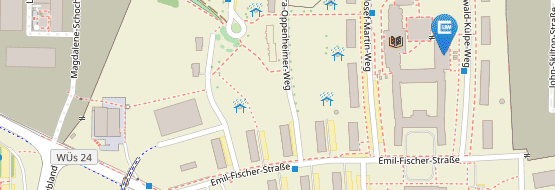Ferdinand Braun
Scholar of the month: Ferdinand Braun
* 06. June 1850 in Fulda † 20. April 1918 in New York
1868 Study of Mathematics, Physics and Chemistry in Marburg and Berlin
1872 Promotion
1874 Teacher for Mathematics and Science in Leipzig
1877 Extraordinary Professorship at the University of Marburg
1880 Transition to the University of Strasbourg
1883 Ordinary Professorship in Karlsruhe
1895 Professorship in Strasbourg
1897 Invention of the cathode ray tube
1909 Nobel Prize together with Guglielmo Marconi
In the last months, the “Scholar of the month”-project was focused entirely on the life and works of special scientists: Every scholar that could call Würzburg a home at some point during their careers and was awarded with the Nobel Prize was thereby presented and honoured. Their achievements profited their fields of research until today, which earned them one of the highest scientific appreciations. Often, these scientists spent important years of their scientific career in Würzburg. Karl Ferdinand Braun will be the last Nobel Laureate (for now) that the University Archive will honour as “Scholar of the month”.
Gifted and promoted
Already during school, a teacher of Karl Ferdinand Braun noticed his outstanding talent for natural science and decisively supported the young student. Already at the age of 14 or 15, Braun wrote a scientific essay about water and one year later a paper about the production of a sulphur-nitrogen-compound. After receiving his A-levels, Braun first started to study Physics, Chemistry and Mathematics at the University in Marburg, but hoped to obtain an even better education by transferring to Berlin. There, the Physicist and Chemist Gustav Magnus also noticed the scientific talent of Landsteiner and offered the possibility to work as his assistant in 1869. As his new employer already died one year later, Braun continued his work under Georg Hermann Quincke, who had a defining impression on him, which is also the reason for the young physicist to write his promotion thesis about a topic from Quincke’s field of research: the influence of stiffness, fixture and amplitude on the oscillation of strings.
Braun’s way to Würzburg
His orientation towards Quincke eventually led to the event of Ferdinand Braun coming to Würzburg. After the former Professor of Physics, August Kundt, received an offer of the re-founded University of Strasbourg, Georg Hermann Quincke became his successor at the Alma Julia and brought Braun as his assistant with him. The time together in Würzburg proceeded to be of little success for both of them. Braun conducted an experiment to measure the conductivity of molten salt without obtaining satisfying results, and also the research question about the possibility to apply Ohm’s law to molten substances and solutions remained unanswered.
From head teacher to professor
After his unlucky period in Würzburg, Braun moved to Leipzig to work at a Gymnasium in 1874, as he successfully passed his exam for mathematics and physics at Gymnasiums one year before. While working as a teacher, he did not stop to conduct his research, but it became more of a hobby than an occupation. He engaged himself with new methods of measuring the resistance in crystals. His scientific career was revived with an offer of a professorship at the University of Marburg, where he could teach and research in the field of electrical engineering. After occupations in Strasbourg and Karlsruhe, Braun came to Tübingen in 1885 and was entrusted - alongside teaching - with building up the new Institute of Physics. After ten busy years, he again went to Strasbourg in 1894.
The prize-worthy discovery
While Braun participated at a scientific conference in North America in 1897, the young Italian Guglielmo Marconi involved himself in the thought to use electromagnetic radiation for the wireless transfer of information. One year later also Braun found interest in this topic. The scientist was therefore in direct competition with the Italian businessman. In 1900, the research group around Braun succeeded in testing the first wireless telegraphic connection between Cuxhaven and Helgoland; In 1901 Marconi managed to send a radio signal over the Atlantic. In November 1909 both of them were awarded with the Nobel Prize in Physics.

Recommended Readings:
Hars, Florian: Ferdinand Braun (1850-1918) – ein wilhelminischer Physiker, Berlin 1999.
Kurylo, Friedrich: Ferdinand Braun: Leben und Wirken des Erfinders der Braunschen Röhre, München 1965.



